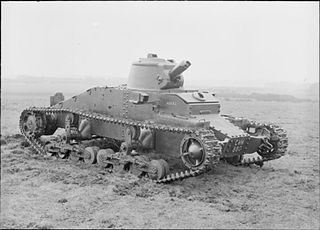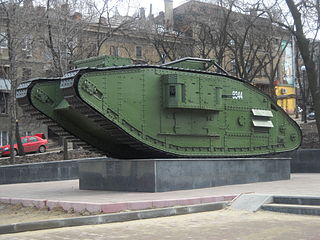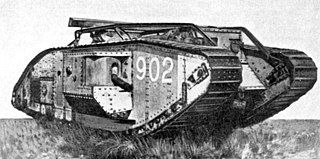
The M3 Lee, officially Medium Tank, M3, was an American medium tank used during World War II. In Britain, the tank was called by two names based on the turret configuration and crew size. Tanks employing US pattern turrets were called the "Lee", named after Confederate general Robert E. Lee. Variants using British pattern turrets were known as "Grant", named after Union general Ulysses S. Grant.

The Tank, Infantry, Mk IV (A22) Churchill was a British heavy infantry tank used in the Second World War, best known for its heavy armour, large longitudinal chassis with all-around tracks with multiple bogies, its ability to climb steep slopes, and its use as the basis of many specialist vehicles. It was one of the heaviest Allied tanks of the war.

The Cruiser tank Mk V or A13 Mk III Covenanter was a British cruiser tank of the Second World War. The Covenanter was the first cruiser tank design to be given a name. Designed by the London, Midland and Scottish Railway as a better-armoured replacement for the Cruiser Mark IV, it was ordered into production in 1939 before pilot models were built. Problems with the design became apparent only after production was under way.

British heavy tanks were a series of related armoured fighting vehicles developed by the UK during the First World War.

The Tank, Infantry, Mk I, Matilda I (A11) was a British infantry tank of the Second World War. Despite being slow, cramped and only armed with a single machine gun, the Matilda I had some success in the Battle of France in 1940, owing to its heavy armour which was proof against the standard German anti-tank guns. It is not to be confused with the later model Tank, Infantry Mk II (A12), also known as the "Matilda II", which took over the "Matilda" name after the Matilda I was withdrawn from combat service in 1940. They were completely separate designs.

The Medium Mark B was a British tank of the First World War developed as a successor to the Whippet, but ultimately unsatisfactory and production was cancelled at the end of the war.

The Mark IX tank was a British armoured fighting vehicle from the First World War. It was the world's first specialised armoured personnel carrier (APC).

The Tank, Cruiser, Ram was a cruiser tank designed and built by Canada in the Second World War, based on the U.S. M3 Medium tank chassis. Due to standardization on the American Sherman tank for frontline units, it was used exclusively for training purposes and was never used in combat as a gun tank. The chassis was used for several other combat roles however, such as a flamethrower tank, observation post, and armoured personnel carrier.

The Gun Carrier Mark I was a British vehicle of the First World War. The gun carrier was designed to transport a 6-inch howitzer or a 60-pounder gun forward soon after an attack to support infantry in advanced positions. Gun carriers were first used in the Battle of Pilckem Ridge during the Third Battle of Ypres. The carriers moved guns and equipment but were used for the rest of the war mainly for carrying equipment and supplies through areas under fire, where porters in the open would have suffered many casualties. The 6-inch howitzer could be fired while mounted, making the Gun Carrier Mark I the first modern self-propelled gun, a weapon capable of independent action and having tactical mobility on the battlefield.
The Tank, Heavy, TOG 1 was a prototype British heavy tank produced in the early part of the Second World War in the expectation that battlefields might end up like those of the First World War. It was designed so it could cross churned-up countryside and trenches. A single prototype was built, and followed by an improved model, but interest faded with the successful performance of another cross-country design, the Churchill tank, and the mobile war that was being fought.

The Tank, Heavy, TOG II* was a prototype British tank design produced in the early part of the Second World War in case the battlefields of northern France devolved into a morass of mud, trenches and craters as had happened during the First World War. When this did not happen the tank was deemed unnecessary and the project terminated. A development of the TOG I design, only a single prototype was built before the project was dropped.

The Flying Elephant was a proposed super-heavy tank, planned but never built by the British during World War I.

The Mark VIII tank also known as the Liberty or The International was an Anglo-American tank design of the First World War intended to overcome the limitations of the earlier British designs and be a collaborative effort to equip France, the UK and the US with a single heavy tank design.

The "Female" tank was a variation of the British Mark I tank deployed during the First World War that carried multiple machine guns instead of the mix of machine guns and cannons mounted on the original Mark Is. Ernest Swinton, instrumental in developing the British tank and co-creator of the term "tank", is credited with inventing these gender-related terms, thinking that the best tank tactics would have the two types attacking in consort.

The Light Tank Mark I to Mark V were a series of related designs of light tank produced by Vickers for the British Army during the interwar period.

The development of tanks in World War I was a response to the stalemate that had developed on the Western Front. Although vehicles that incorporated the basic principles of the tank had been projected in the decade or so before the War, it was the alarmingly heavy casualties of the start of its trench warfare that stimulated development. Research took place in both Great Britain and France, with Germany only belatedly following the Allies' lead.

Little Willie was a prototype in the development of the British Mark I tank. Constructed in the autumn of 1915 at the behest of the Landship Committee, it was the first completed tank prototype in history. Little Willie is the oldest surviving individual tank, and is preserved as one of the most famous pieces in the collection of The Tank Museum, Bovington, England.

The British Mark V tank was an upgraded version of the Mark IV tank. It was first deployed in 1918, used in action during the closing months of World War I, and in the Allied intervention in the Russian Civil War on the White Russian side, and by the Red Army, after they were captured. The tank was improved in several aspects, chiefly the new steering system and engine, but it fell short in other areas such as mechanical reliability and its insufficient ventilation. However, the Mark V was successful, especially given its limited service history, and primitive design.

The Mark IV was a British tank of the First World War. Introduced in 1917, it benefited from significant developments of the Mark I tank. The main improvements were in armour, the re-siting of the fuel tank and ease of transport. A total of 1,220 Mk IV were built: 420 "Males", 595 "Females" and 205 Tank Tenders, which made it the most numerous British tank of the war. The Mark IV was first used in mid 1917 at the Battle of Messines Ridge. It remained in British service until the end of the war, and a small number served briefly with other combatants afterwards.

The Tiger Ilisten (help·info) is a German heavy tank of World War II that was employed from 1942 in Africa and Europe, usually in independent heavy tank battalions. Its final designation was Panzerkampfwagen VI Tiger Ausf. E often shortened to Tiger. The Tiger I gave the German Army its first armoured fighting vehicle that mounted the 8.8 cm KwK 36 gun. 1,347 were built between August 1942 and August 1944. After August 1944, production of the Tiger I was phased out in favour of the Tiger II.























